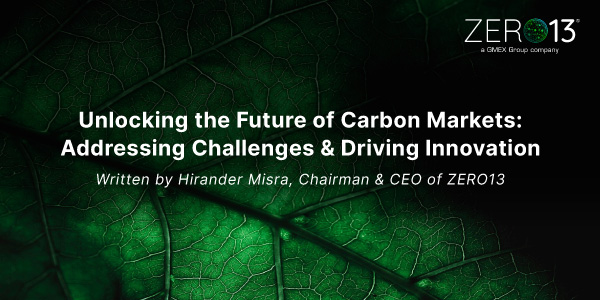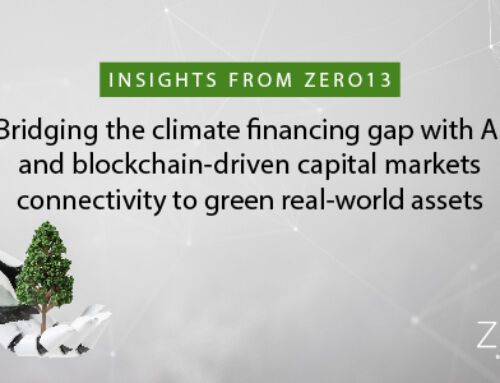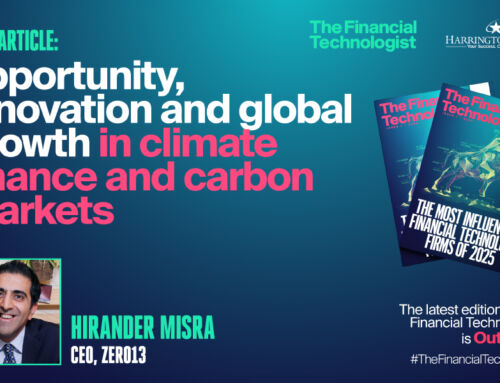On September 10th, 2024, ZERO13 and the Climate and Energy Transition Finance Initiative (CETFI) co-hosted an insightful webinar aimed at exploring the dynamic and rapidly evolving world of carbon markets. This event brought together influential industry figures to collaborate on novel strategies in carbon trading, investment, and settlement, with the ultimate goal of unlocking the immense potential of future carbon markets.
The discussion was moderated by Sanmit Ahuja, Founding Director of CETFI and MD & CEO of Bharatia. Sanmit, with his extensive experience in green finance and technology transfer, led a group of experts: Dinesh Babu, Executive Director at InfraBlocks Capital Singapore, renowned for his work in renewables, carbon management, and climate action data transparency; Pradeep Kumar, Secretary of the Forest and Environment Department, Government of Sikkim, who provided valuable insights on environmental policies and sustainability; Hirander Misra, Chairman & CEO of ZERO13, a key figure in climate fintech, recognised for his award-winning contributions at COP28 UAE and the World Economic Forum week in Davos; Henrik Wiig, Associate Professor at Oslo Nye Høyskole, specialising in rural development and economic research; and Professor Lisa Wilson, Global Head of Strategic Partnerships at Green Bond Corporation and a renowned thought leader in ESG, blockchain, and digital assets. Together, they discussed critical themes surrounding green finance, sustainability, technology, and policy, offering insights and forward-thinking strategies for the future of carbon markets.
Challenges in Carbon Markets
The discussion began by highlighting one of the most pressing issues: the significant financing gap in the carbon market. Although voluntary carbon markets are valued at around $18 billion1, the global demand for financing climate action is estimated at $4 trillion annually2. This gap is a barrier to achieving net-zero targets and advancing sustainability initiatives, especially in developing nations. During the discussion, the panel highlighted how the fragmentation of carbon markets, diverse pricing mechanisms, and absence of standardisation act as significant barriers, hindering the development of an efficient and fair marketplace for carbon trading.
A crucial insight discussed during the webinar was the notable price gap between carbon credits originating from developed markets and those from emerging economies, showcasing the challenges faced by regions like Africa and Southeast Asia in the carbon trading landscape. Although carbon credits in developed markets command higher prices, those from regions like Africa and Southeast Asia are undervalued, undermining the potential impact of carbon projects in these areas and posing challenges to market participation and sustainability efforts. This imbalance reduces incentives for local communities to engage in carbon projects, ultimately slowing down the global carbon market’s development.
Building Trust and Transparency
The importance of transparency and trust in carbon markets was emphasised as essential for attracting institutional capital. It was noted that to bridge the financing gap, carbon assets must be turned into “investment-grade” commodities that traditional capital markets can invest in. This requires robust and transparent frameworks that ensure the integrity of carbon credits. The panellists shared insights on how technology, particularly blockchain, can play a critical role in ensuring transparency from credit generation to trading and settlement. By providing digital provenance and robust data tracking, some platforms such as CAD Trust (Climate Action Data Trust, which is backed by the World Bank, Singapore Government and IETA) are driving the shift toward a more transparent and trustworthy carbon market.
Blockchain technology, by enabling secure and immutable records, ensures that the entire lifecycle of a carbon credit is transparent, from its creation to its eventual sale or retirement. This level of visibility addresses common concerns about greenwashing and double-counting, thus fostering greater confidence among institutional investors. Additionally, it was emphasised that integrating AI and blockchain to create a more interconnected digital ecosystem can further reinforce the credibility of carbon markets, making them more accessible to both large-scale investors and smaller project developers.
The conversation also touched on the role of digital measurement, reporting, and verification (dMRV) as tools to enhance the credibility of carbon credits. This, in turn, builds confidence among investors and buyers, reducing risks and encouraging market participation. dMRV, by digitising the reporting process, ensures that all the data related to carbon credits is consistently monitored and verified in real time. The seamless integration of technology into this process removes human error and manual reporting, which are often the cause of discrepancies and mistrust in the system.
The Role of Structured Products
Another crucial discussion point revolved around the use of structured financial products and innovative financing tools such as green bonds, derivatives, and forward carbon credits. These tools can help make carbon markets more efficient by providing price transparency and creating a robust, liquid market. By blending public and private capital, these instruments could fill the financing gap and encourage investment in climate initiatives, particularly in emerging markets.
Structured products offer a way to de-risk carbon investments, allowing a wider range of investors to participate. By securitising carbon credits and attaching them to green bonds or other financial instruments, market participants can create a more stable investment environment that is attractive to large institutional investors. These products are essential in bridging the gap between supply and demand, particularly in emerging markets where financial products are not as well developed.
Moreover, the creation of forward carbon credits allows companies to lock in prices for future carbon credits, providing greater predictability and price stability. The introduction of these instruments is expected to boost market liquidity and allow for the development of more sophisticated trading mechanisms. Participants agreed that structured products, combined with regulatory frameworks, could offer a path forward for the development of a global carbon market that is both equitable and efficient.
A Network of Networks
The webinar highlighted the need for a collaborative “network of networks” approach to foster market interoperability and break down existing silos in the carbon market such as that being provided by platforms such as ZERO13. By creating connections between various carbon exchanges, registries, and financial institutions, market participants can scale efforts to meet climate action goals. This interconnected network can provide the much-needed infrastructure for seamless cross-border carbon trading, ultimately driving up efficiency and liquidity.
Public-private partnerships are crucial to this collaborative approach. Governments and regulatory bodies can work together with private enterprises to create standards that ensure transparency and trust across the board. By developing standardised frameworks and protocols, the carbon market can mature, providing opportunities for sustainable investments while addressing global climate challenges.
The importance of public-private partnerships was also discussed, emphasising how collaboration between governments, private companies, and investors could lead to more sustainable outcomes. A combined effort could streamline processes such as credit issuance, verification, and trading, thereby enabling quicker and more efficient market operations. Participants stressed that carbon markets need to be scaled up not just locally but globally, with both developed and emerging markets benefiting from this network of networks.
Moving Forward
In conclusion, the speakers stressed the need for a holistic approach to carbon markets—one that integrates technology, transparency, and collaboration. As the market continues to evolve, platforms like ZERO13 and initiatives like CETFI are paving the way for a future where carbon trading, investment, and settlement are more transparent, equitable, and impactful.
The discussion concluded with a call for more inclusive carbon markets that democratise access to both buyers and sellers, ensuring that local communities benefit from the carbon economy. Panellists urged continued innovation in technology and financial products to help close the multi-trillion-dollar annual financing gap in climate action.
Finally, the panellists emphasised that the ultimate success of carbon markets depends on the continued evolution of regulatory frameworks, innovative financial instruments, and technological integration. These factors will shape the future of global carbon markets and determine how effective they are in driving meaningful climate action. The webinar reinforced that while challenges remain, the opportunity for global cooperation and innovation offers a pathway to a more sustainable future.
Sources
MSCI, Investment Trends and Outcomes in Carbon Markets, available at: https://www.msci.com/www/research-report/investment-trends-and-outcomes/04638716796
UNCTAD, Trade and Development Report 2023, available at: https://unctad.org/publication/trade-and-development-report-2023





